
Calathea is a genus of plants with many different species. It can be hard to recognize one variety from the next, as many are very similar to each other. So, how do you identify your Calathea plant? How many different species of Calathea plants are there?
Calathea has over three hundred cultivars split up amongst several dozen species, including the more common Calathea Lancifolia, Zebrina, and Ornata that are available at nurseries and online retailers. However, rarer species such as the White Fusion and Velvet Touch are gaining popularity.
In this article, you will learn the proper way to identify 10 of the most popular Calathea plants
Lets take a look:
| Calathea Varieties | Rarity | Price Range (USD$) |
|---|---|---|
| Calathea Lancifolia | Common | $20 to $30 USD |
| Calathea Zebrina | Common | $20 to $30 USD |
| Calathea Makoyana | Common | $20 to $40 USD |
| Calathea Crocata | Common | $15 to $30 USD |
| Calathea Roseopicta | Common | $20 to $40 USD |
| Calathea Ornata | Rare | $25 to $40 USD |
| Calathea Beauty Star | Rare | $25 to $40 USD |
| Calathea Orbifolia | Rare | $25 to $40 USD |
| Calathea Warscewiczii | Rare | $30 to $100 USD |
| Calathea Network | Very Rare | $40 to $100 USD |
| Calathea White Fusion | Very Rare | $50 to $100 USD |
How do you Identify a Calathea?
Calatheas are best known for their stunning foliage. Many varieties in this genus have interesting patterns of variegation on the tops of their leaves. A reddish or purple color on the leaves’ undersides creates a beautiful contrast against the greenery.
Calathea is one genus under the Manantaceae family. Because many species in this family are known as Prayer Plants (which is actually more accurately attributed to Calathea’s cousin, Maranta), species in this genus are sometimes mislabeled.
In order to differentiate one Calathea species from another, here are the main things to look out for:
- Leaf shape and size
- Leaf texture
- Leaf color and variegation pattern
- Overall plant size and growth habit
- Flowers
Here’s your definitive guide to 10 popular calathea species so you can know exactly what you’re getting!

Let’s start our list with the more common Calathea types. These 5 varieties are most likely to be found at your local nursery or garden supply store.
Calathea Lancifolia
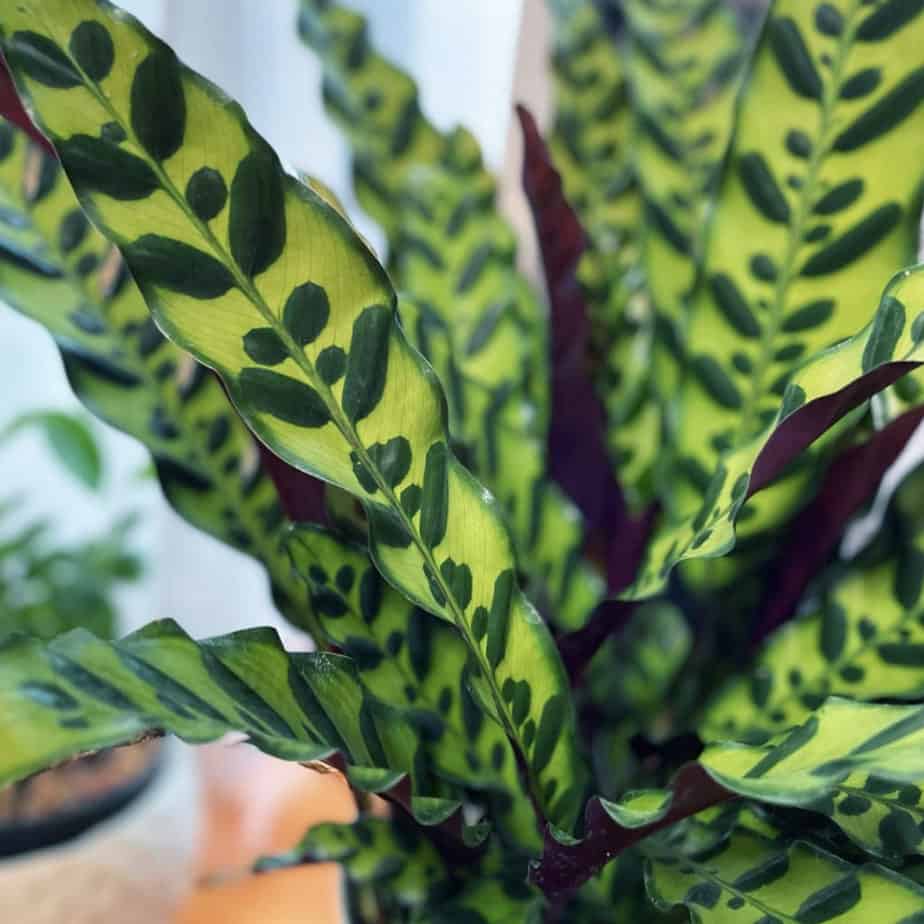
Calathea Lancifolia, also known as the Rattlesnake Plant, is one of the most common varieties you’ll find. It is also said to be the easiest Calathea to care for, so this is a great place to start your collection.
Lancifolia Distinguishing features:
- Leaf shape and size: Calathea Lancifolia’s leaves are long and narrow like a lance or sword. They can grow up to about 12 inches (30 centimeters) long.
- Leaf texture: The leaves on this variety are thick and glossy. They have a wavy, bubbly texture.
- Leaf color and variegation pattern: Leaves on the Rattlesnake Plant are bright green with dark green oval-shaped “bubbles” on either side of the central leaf vein, similar to rattlesnake patterning on its back. The undersides of the leaves are reddish-purple. The dark green spots appear on both sides of the leaves.
- Size and growth habit: This Calathea grows a little bit smaller than other varieties, no more than 18 inches (45 cm) tall.
- Flowers: Calathea Lancifolia blooms in the spring. It has yellow flowers on 4-inch spikes. However, Blooms are rare if you kept them as indoor plants.
Lancifolia Care tips
This Calathea is less of a drama queen than some of its cousins.
In general, Lancifolia responds well to standard Prayer Plant care. Make sure to keep temperatures between 60°F and 85°F, keep the humidity up, and pot in a coarse, well-draining soil mix.
Lancifolia Fun facts
Lancifolia isn’t the only Calathea with the nickname of “Rattlesnake Plant.” Its cousin, C. Crotalifera shares the same name because its flowers look like a rattlesnake tail. Its leaves, unfortunately, are far less interesting; they look very similar to that of a Bird of Paradise plant.
Calathea Zebrina

Calathea Zebrina is another variety that won’t be too hard to find. It lives up to its nickname, Zebra Plant, with its velvety leaves and interesting stripes!
Zebrina Distinguishing features:
- Leaf shape and size: The oblong leaves can grow to be over 12 inches long.
- Leaf texture: The Zebra Plant’s leaves are thick and velvety to the touch.
- Leaf color and variegation pattern: Like many other Calatheas, Zebrina has striped leaves. The background of the leaf is a bright, almost neon green. Thick, dark green stripes extend from the center vein to the leaf margin.
- Plant size and growth habit: A mature Calathea Zebrina plant grows a bit over 2 feet (60 cm) wide and tall.
- Flowers: C. Zebrina blooms in the spring with purplish-white flowers. This is rare if grown indoors.
Zebrina Care tips
Care for your Zebrina as you would any other calathea: Keep temperatures between 65°F and 85°F, keep the humidity up, and pot in a coarse, well-draining soil mix.
Zebrina Fun facts
This plant will fold its leaves at night, earning its nickname “Prayer Plant.” This species is native to Brazil.
Calathea Makoyana

Calathea Makoyana also known as the Peacock Plant has stunning foliage pattern that is sure to make your home feel like a tropical jungle!
Makoyana Distinguishing features:
- Leaf shape and size: Makoyana’s leaves are shaped a bit like an egg. The base of the leaf near the petiole (leaf stem) is wide, and the tip of the leaf narrows to a point.
- Leaf texture: Makoyana leaves texture are paper-thin with some very subtle waves.
- Leaf color and variegation pattern: Makoyana’s leaves are glossy and shiny. They have a similar color pattern to C. Lancifolia, with dark green “bubbles” on a lighter background. These leaves also have some silvery streaks that start from the center vein but don’t quite make it to the leaf margin. The leaf undersides are pinkish-red, and the petioles are red.
- Plant size and growth habit: This Calathea reaches a mature height between 12 and 20 inches.
- Flowers: Makoyana produces small, white flowers in spring (uncommon if living indoors).
Makoyana Care tips
Like other Calatheas, Makoyana love humidity! Consider placing a humidifier near your Cathedral Plant to keep its foliage from browning at the tips.
Makoyana Fun facts
You don’t have to worry about your pets around this plant. It is non-toxic to dogs and cats (all calatheas are pet-friendly).
Calathea Crocata
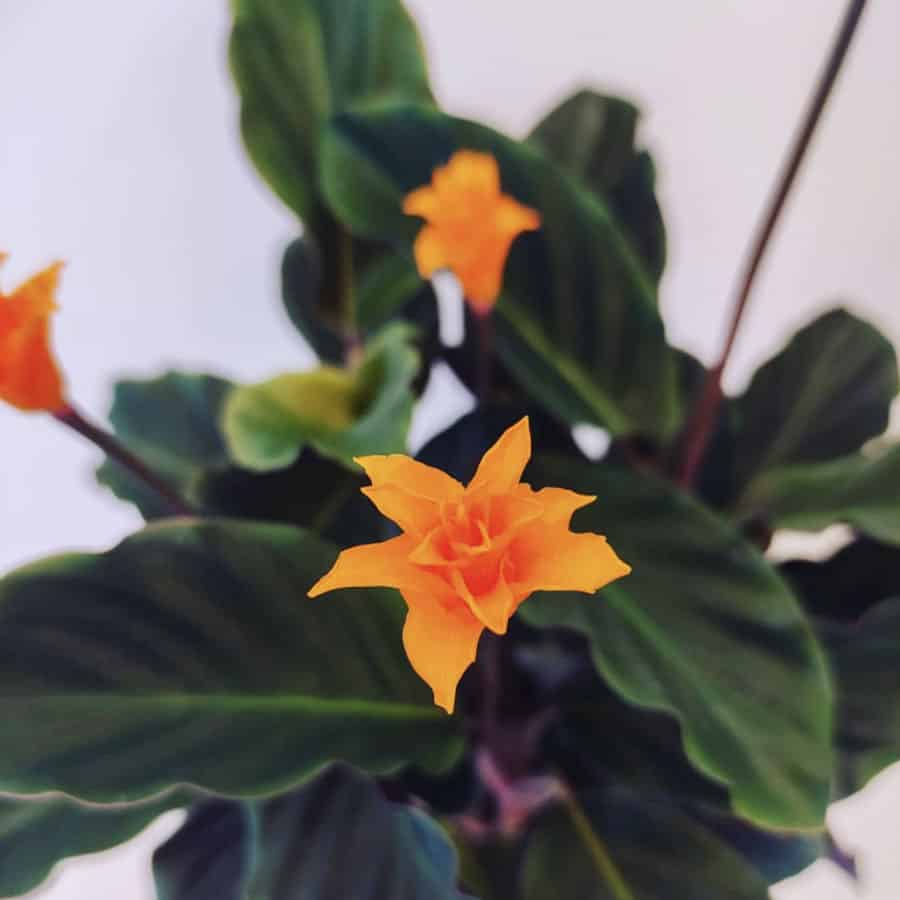
Most Calathea are known for their beautiful leaves, but Crocata (also know as the Eternal Flame) is actually grown for its flowers! These yellow-orange blooms stand out against the plain green foliage.
Crocata Distinguishing features:
- Leaf shape and size: Crocata’s leaves are oval-shaped, coming to a gentle point at the tips.
- Leaf texture: The leaves have a wavy, ruffled texture.
- Leaf color and variegation pattern: Leaves are a metallic green on top and deep purple underneath. This calathea species has no patterned variegation on its leaves.
- Plant size and growth habit: At maturity, this plant will grow to be between 1 and 2 feet tall and wide.
- Flowers: Yellow-orange flowers appear in the spring and last 2 to 3 months. Long flower spikes elevate the complex flowers to the top of the foliage where they are plainly visible.
Crocata Care tips
The Eternal Flame plant needs similar care as other Calatheas. The best time to repot this species is in late June once its flowers have faded.
Crocata Fun facts
Like its Prayer Plant cousins, Crotatas will fold up their leaves at night.
Environmental damage in Brazil, Crocata’s native habitat, has made it much harder to find this flower species in the wild.
Calathea Roseopicta
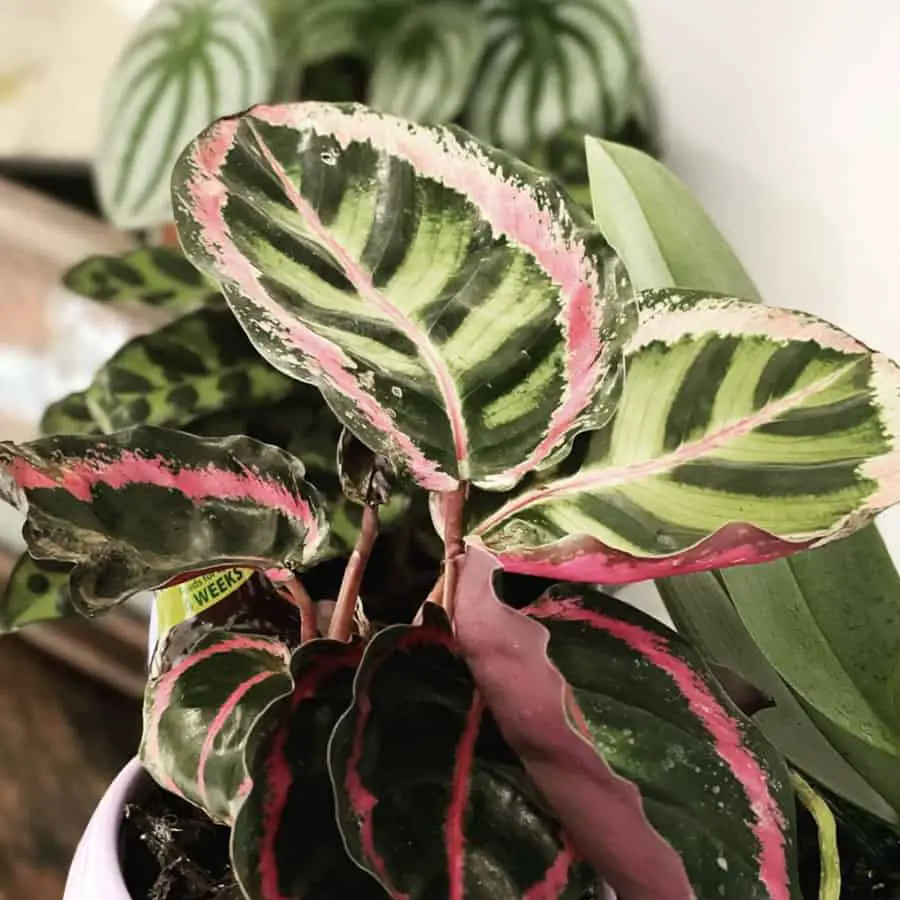
Calathea Roseopicta (also known as Rose-Painted Calathea) has many cultivars within its species. They all have the same “crown” of color contrast around the leaf edges.
Popular cultivars
- Cynthia
- Corona
- Dottie
- Rosey
- Medallion
Roseopicta Distinguishing features:
- Leaf shape and size: The leaves of the Rose-Painted Calathea are big and round with very long petioles. They are almost as wide as they are long.
- Leaf texture: These leaves have a moderate wave to them.
- Leaf color and variegation pattern: There are many different cultivars within the C. Roseopicta species, and each has a different coloration pattern. What they all have in common is a “crown” of color that runs around the entire margin, making it look like there is a leaf within a leaf. Common colors are green, silver, pink, and purple. The leaf undersides are reddish or purplish.
- Plant size and growth habit: These plants can grow up to 30 inches tall due to their long petioles.
- Flowers: Calathea Roseopicta blooms in the summer. Its small flowers are white and purple.
Roseopicta Care tips
C. Roseopicta needs similar care to other Calatheas. Be careful not to place it in direct sunlight, or else its beautiful leaves could get a sunburn, which will cause them to turn crispy and brown.
These rare Calathea species are probably not going to be at your local big-box gardening store, although you may be able to find them at some specialty plant shops. You will have better luck finding these beauties online.

Calathea Ornata / Pinstripe
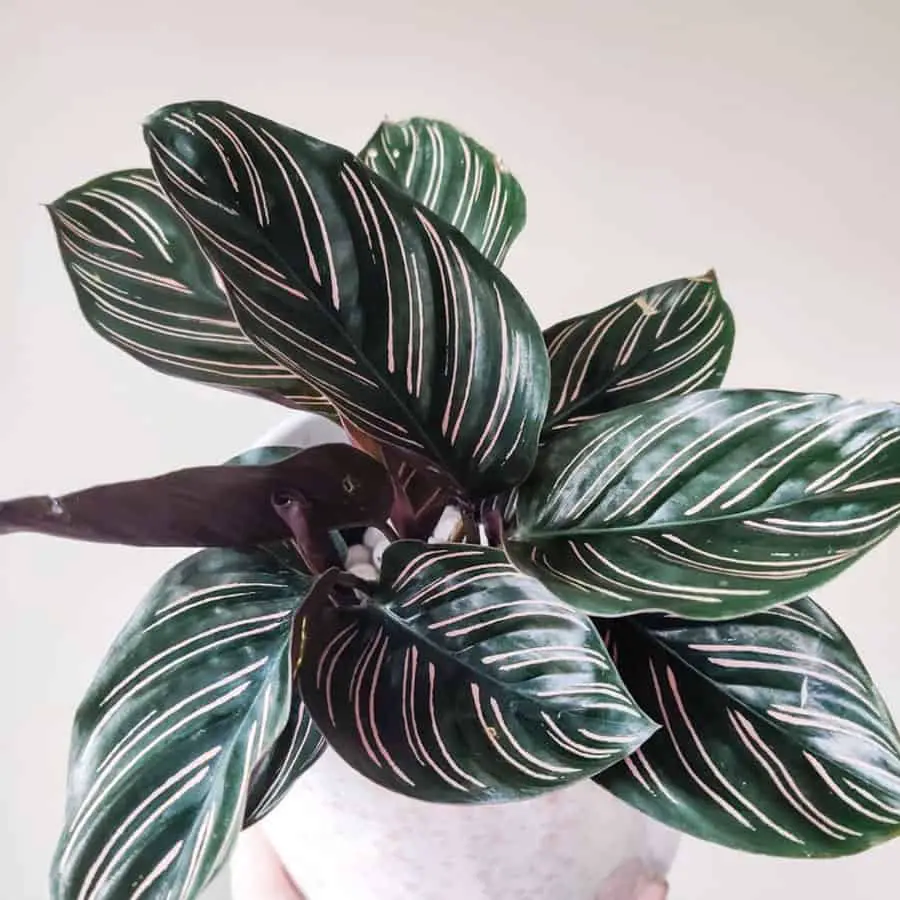
The Pinstripe Calathea is uniquely beautiful with its pink pinstripes that look like they were hand-painted on each leaf. This plant has an air of sophistication that fits in nicely with modern decor.
Ornata Distinguishing features:
- Leaf shape and size: The Calathea Pinstripe has oblong leaves that narrow a little bit near the tip. The leaf petioles are long, which allows this plant to have a taller appearance.
- Leaf texture: Like other Calatheas, the Pinstripe Plant has stiff leaves. However, they are not wavy like so many others. These leaves are relatively flat and smooth compared to their relatives.
- Leaf color and variegation pattern: C. Ornata displays dark green leaves with light pink pinstripes that feather out from the center. These pink stripes are somewhat irregular and look as if they had been painted on by hand. The underside of the leaves are reddish.
On mature specimens, the pink stripes will fade to white and may disappear to be replaced with yellowish-green brush patterns. Mature Pinstripe Calatheas will also lose the reddish color under their leaves, which gets replaced with a deep green. - Plant size and growth habit: With its long leaf stems, this plant can grow up to 2 feet tall and wide at maturity. It has an upright clumping growth habit.
- Flowers: Mature Calathea Ornata produces orange flowers.
Ornata Care tips
Pinstripe Calathea needs similar care to other Calatheas. Bright (indirect) light will intensify the color of the foliage. Just make sure not to keep it in direct sunlight.
Ornata Fun facts
Calathea Ornata grows wild in Colombia and Ecuador.
Ornata Other Cultivars
There is also Calathea Ornata ‘Sanderiana’ which looks very similar to its parent c. ornata, but its leaves are not as long and form a rounder shape.
Calathea Beauty Star
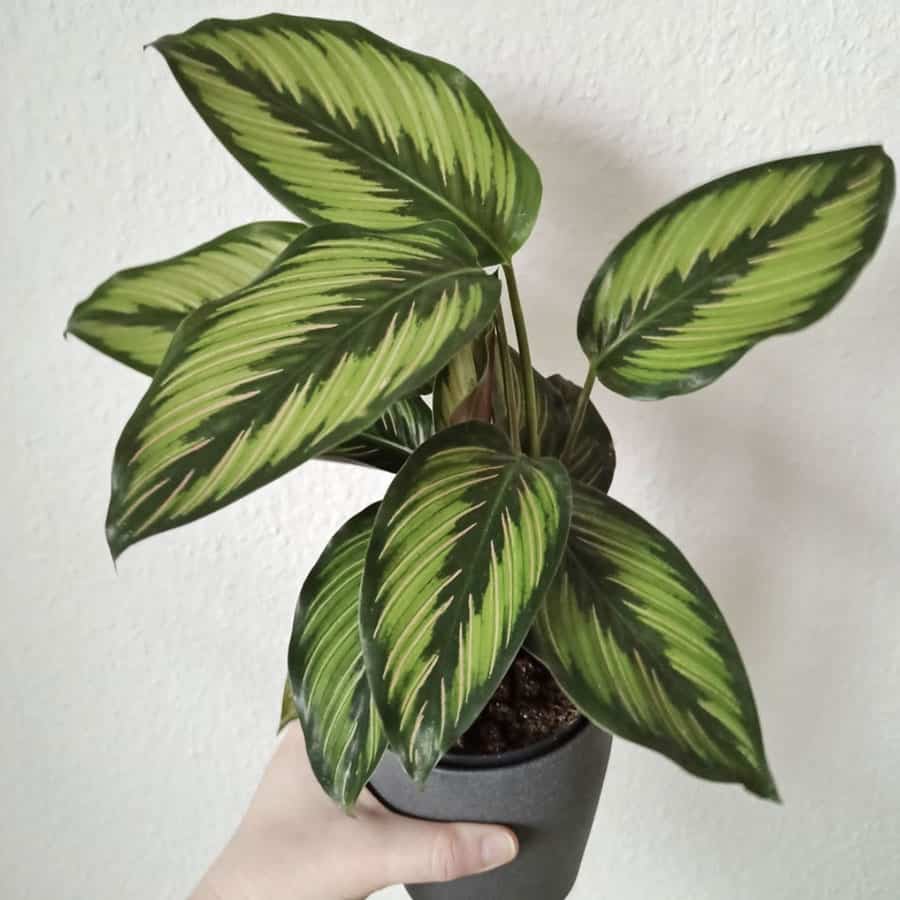
Calathea Beauty Star has similar pink stripes as Calathea Ornata, but instead of plain dark green leaves, it has wide swaths of bright green on either side of the central vein. This adds even more beauty and interest to the hand-painted effect.
Beauty Star Distinguishing features:
- Leaf shape and size: Beauty Star’s leaves are long and a bit narrow, coming to a point at the tip.
- Leaf texture: These leaves have a very subtle wavy texture along its lateral veins.
- Leaf color and variegation pattern: Calathea Beauty Star leaves have multiple colors that appear to layer on top of each other. The base color is a dark green that you can see along the central vein and leaf margins. On either side of the central vein are patches of a lighter green that look as if someone painted them on with a wide brush.
Most striking are the pale pink pinstripes, similar to C. Ornata, which run parallel to the lateral veins. These stripes look somewhat irregular as if each one was painted delicately by hand. The leaf undersides are a rich purple. - Plant size and growth habit: Beauty Star Calatheas grow upright with a dense clumping habit. This makes it a great houseplant, as it won’t try to climb out of its pot like a Monstera.
- Flowers: This Calathea is known for its beautiful leaves rather than its flowers. It will rarely flower when grown indoors as a houseplant.
Beauty Star Care tips
Calathea Beauty Start needs similar care to other Calatheas. They like to be watered frequently, but will suffer from root rot if the soil does not drain well. Use a coarse potting mix with these drama queens. An easy way to achieve this is by blending an orchid potting mix, which is mostly bark, with a well-draining potting soil.
Beauty Star Fun facts
Like other plants in the Marantaceae family, the Beauty Star will close up its leaves at night as if to pray.
Calathea Orbifolia
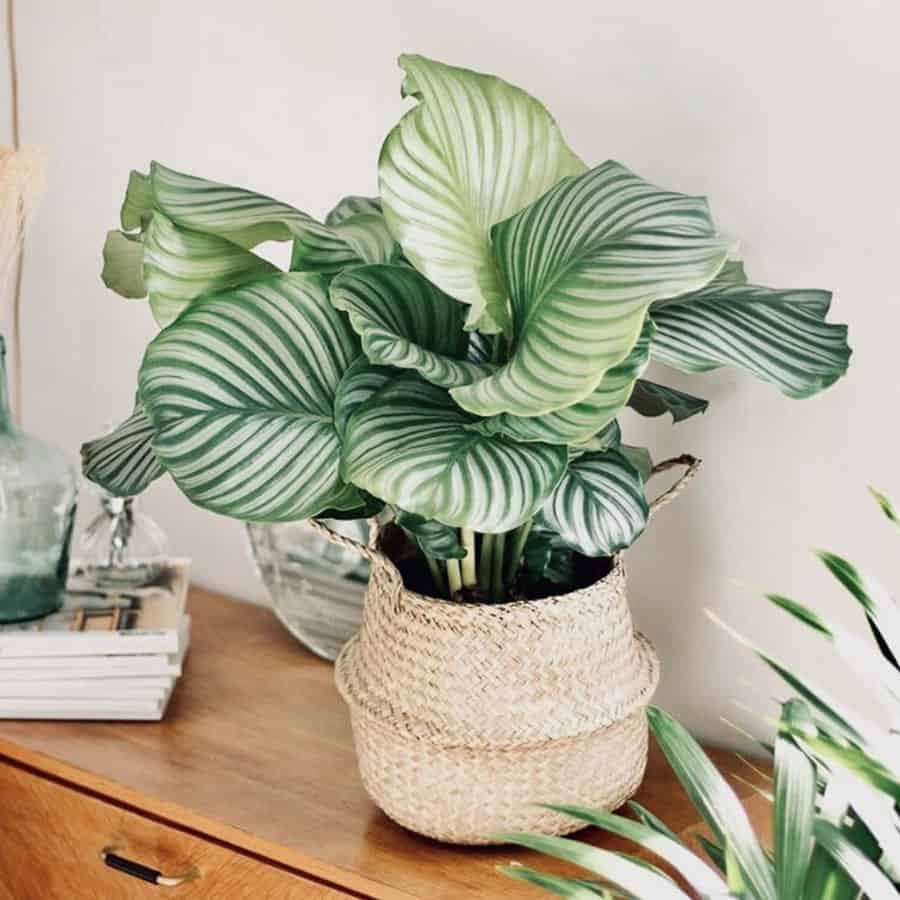
Calathea Orbifolia (also known as Orbit Peacock Plant) is one of the larger Calathea species. Its big, round leaves are sure to bring a tropical feeling to any room in your home. It tends to be a bit hard to find, but its popularity is increasing.
Orbifolia Distinguishing features:
- Leaf shape and size: Orbifolia’s leaf shape is what makes it stand apart from its cousins. These leaves are very large and very round. They can grow to be over a foot wide!
- Leaf texture: The leaves have a very slight wave along the lateral veins.
- Leaf color and variegation pattern: Orbifolia’s leaves are very shiny. Their main color is a metallic, silvery green which contrasts against darker green stripes along the central and lateral veins. The undersides of the leaves are also green.
- Plant size and growth habit: This is one of the larger Calathea species. They can grow up to about three feet tall and wide.
- Flowers: Mature specimens will produce small, white flowers on a short flower spike.
Orbifolia Care tips
Calathea Orbifolia need similar care to other Calatheas. Orbifolia needs high humidity to prevent leaf curl or crisping. Tap water can also cause the leaf margins to turn brown and crispy, so you should only use distilled water or rainwater for this plant.
Orbifolia Fun facts
Calathea Orbifolia is native to the jungles of South America. They thrive on the forest floor with dappled sunlight, high humidity, and warm temperatures year round.
Calathea Warscewiczii (Velvet Touch)
Many people have trouble pronouncing this Calathea’s proper Latin name, so it is commonly known as Velvet Touch. True to its name, this species has irresistible soft, velvety leaves. Once you get to touch one, it will be at the top of your plant wish list until you bring it home!

Velvet Touch Calathea Distinguishing features:
- Leaf shape and size: The leaves of the Jungle Velvet are long and lance-shaped. Mature plants will have leaves over a foot long.
- Leaf texture: This variety is best known for its velvety leaf texture!
- Leaf color and variegation pattern: Velvet Touch Calathea has dark green with a distinct light green fishtail pattern along the center vein. The leaf undersides are deep purple.
This species is often confused with C. Albertii/Misto due to their similar patterning. However, Albertii does not have the same velvety texture to its leaves, so that’s how you distinguish them from a true Velvet Touch. - Plant size and growth habit: This is another one of the larger Calathea species; it can grow up to 3 feet tall. It has an upright, clumping habit.
- Flowers: Mature C. Warzcewiczii will produce creamy yellow and white flowers on long spikes. These flowers look like roses when viewed from above.
Velvet Touch Calathea Care tips
Your Velvet Touch needs the same kind of care as other Calathea. To propagate this species, rather than try to take a cutting (as you would for a Pothos or Monstera), you need to split the roots and rhizome into two or more plants when repotting.
Velvet Touch Calathea Fun facts
This species of Calathea is named after Józef Warszewicz, a Polish botanist, biologist, and plant collector.

These two Calathea species are very beautiful, but very hard to get your hands on. You will need to visit online plant shops, and you may still need to wait until they come back in stock.
Calathea Musaica (Network)

This Calathea cultivar has a leaf pattern so different from any of the rest on this list, you probably wouldn’t realize that it is in the same family! The tiny stripes in between each lateral vein create a pattern (or a network, hence the name) of rectangles that resemble a mosaic tile pattern. It is very exotic, and quite unlike any other houseplant I’ve ever seen!
Popular names
This plant has many different names as it has been shuffled around different genuses within the Marantaceae family. It is no longer classified within the Calathea genus, but the name “Calathea Musaica” has stuck around due to its wide recognition.
- Original name: Maranta Bella
- Calathea Bella
- Calathea Musaica
- Calathea ‘Network’
- Network Prayer Plant
- Current official name: Goeppertia kegeljanii
Musaica Distinguishing features:
- Leaf shape and size: These leaves have a wide oval shape that comes to a point at the leaf tip.
- Leaf texture: Network Plant leaves have a gentle arch, and they look almost droopy. They tend to be a little wavy at the leaf margins.
- Leaf color and variegation pattern: These bright green leaves have an intricate mosaic pattern spread across the entire leaf face. Dark green stripes run along the lateral veins from the center of the leaf all the way to the margins. In between these stripes are hundreds of small, perpendicular stripes that create tons of little, irregular rectangles across the leaf. Network’s leaf undersides are not red or purple.
- Plant size and growth habit: This plant grows full and bushy. It will grow to about 2 feet tall and wide.
- Flowers: Mature specimens will produce small, white flowers on multiple 4-inch flower spikes that grow directly from the rhizome.
Musaica Care tips
The Network Plant is supposed to be easier to care for than other Calathea, although the care requirements are similar. You should repot only when your plant is getting crowded. Repotting too soon can lead to issues like waterlogging and root rot.
Musaica Fun facts
Plant breeders in Holland have developed a more compact variety of this plant, named Calathea musaica ‘PP0005.’ It grows in a compact, bushy shape with smaller leaves and a stronger color contrast in the mosaic pattern.
Calathea White Fusion

This extremely rare Calathea is the only one on this list with a truly variegated pattern. Its unpredictable patches of green and white make the White Fusion a beautiful addition to your houseplant collection. Watch out though: this one is a major diva.
White Fusion Distinguishing features:
- Leaf shape and size: The leaves of Calathea White Fusion are long, narrow, and abnormally-shaped. No two leaves have the same exact shape, even on the same plant.
- Leaf texture: These leaves have irregular waves that correspond with the color variegation.
- Leaf color and variegation pattern: White Fusion sports a beautiful marbling of green and white, with splashes of lighter green in between. The leaf undersides are purple like that of lilacs.
- Plant size and growth habit: This Calathea is a bit smaller than average. It has the typical upright, clumping habit of others in its family.
- Flowers: This species will produce small, white flowers when it reaches maturity.
White Fusion Care tips
White Fusion Calatheas are total divas, like any plant with lots of white variegation on its leaves. Too much light will cause browning and discoloration from sunburn. Not enough light, and the plant won’t develop those beautiful white variegation patches. Avoid south-facing windows or diffuse the light with a sheer curtain.
Cut back any dead or crispy leaves at the base of the stem. New leaves will grow to take their place in no time.
White Fusion Fun facts
Calatheas are a fairly common houseplant. Even the rare White Fusion are not as expensive as some Monstera varieties. Calathea prices top out around $50 USD for a single plant.

